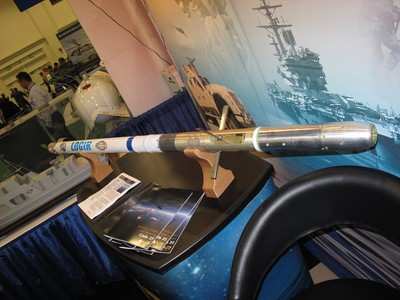LCITS Gives Helo Pilots Advanced "Fire And Forget"
Capability
When officials from the Office of Naval Research (ONR) showed up
at the 63rd annual Naval Helicopter Association (NHA) Symposium in
San Diego from May 9-12, they displayed a technology that allows
helicopter aircraft commanders to “take the fight away from
the boat.”

LCITS On Display U.S. Navy Photo
The Low-Cost Imaging Terminal Seeker (LCITS) will give
helicopters, such as the MH-60 and the AH-1 Cobra that protect
fleet ships, a new-found tactical advantage. The LCITS system
enables pilots to designate a target, fire a rocket and move on to
the next threat. This essentially offers a "fire and forget"
capability, which relieves the pilot of the responsibility of
guiding the weapon to the target during the time of flight, as is
the case with laser-designated weapons. For pilots, that means a
faster response when countering threats.
Lt. Col. Raymond Schreiner, a developmental test pilot from
China Lake’s Naval Air Warfare Center’s Weapons
Division in California, fired a prototype LCITS weapon and
witnessed the LCITS’ capability firsthand. “Putting
this on a helicopter gives us the ability to take the fight away
from the boat,” Schreiner said. “The LCITS technology
appears to be well suited for engaging multiple, high-speed
seaborne targets in a very short period of time.”
The LCITS system comprises three main components: the algorithms
that calculate targeting and transfer alignment data; a digital
smart launcher; and the prototype LCITS weapon. The system is a
collaborative effort among several partners, including South Korea;
the Defense Advanced Research Projects Agency; the Office of the
Secretary of Defense; and the Navy International Program Office,
all of which helped advance its optical sensors and infrared-seeker
technologies. “The LCITS program is a wonderful example of
how investments in multiple technologies can come together and
produce a new capability for the naval warfighter,” said
Michael Deitchman, director of ONR’s Naval Air Warfare and
Weapons Department.

Deitchman also praised the LCITS system’s ability to
accomplish the mission with little to no support. “The LCITs
program is considered "low cost" because it is an augmentation or
upgrade to a pre-existing 2.75-inch rocket system,” Deitchman
said. “Instead of relying on costly parts, sensors and
guidance systems, it relies on the aircraft systems to provide the
targeting information.”
LCITS is undergoing further testing as part of the Medusa Joint
Capability Technology Demonstration (JCTD). Medusa JCTD’s
goal is to integrate the rocket onto the MH-60 aircraft platform.
It will also demonstrate the LCITS’ capability to defend
against multiple fast-attack craft threats from various directions
and ranges. Demonstrations will show the rocket system's potential
to defeat these targets. ONR’s participation in the NHA event
underscores the Navy’s commitment to develop technology for
the helicopter community. With more than 3,000 active-duty,
Reserve, retired and corporate members, the association says its
mission is to enhance the professionalism of military personnel
working in the rotary wing aviation field.
The NHA’s annual symposium is a platform for
collaboration, discussion and a chance to address challenges facing
the entire naval rotary wing community, including the Navy, Marine
Corps and Coast Guard.
 NTSB Final Report: Rutan Long-EZ
NTSB Final Report: Rutan Long-EZ ANN FAQ: Turn On Post Notifications
ANN FAQ: Turn On Post Notifications Classic Aero-TV: ICAS Perspectives - Advice for New Air Show Performers
Classic Aero-TV: ICAS Perspectives - Advice for New Air Show Performers ANN's Daily Aero-Linx (06.28.25)
ANN's Daily Aero-Linx (06.28.25) Aero-News: Quote of the Day (06.28.25)
Aero-News: Quote of the Day (06.28.25)




